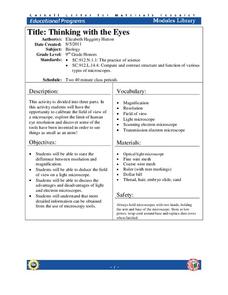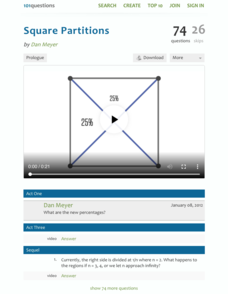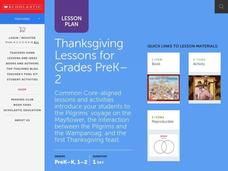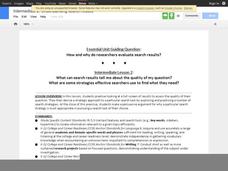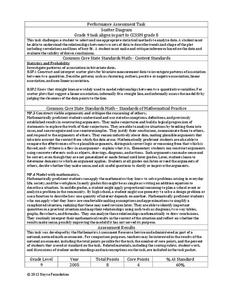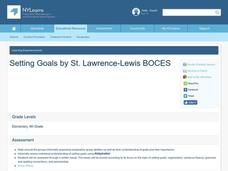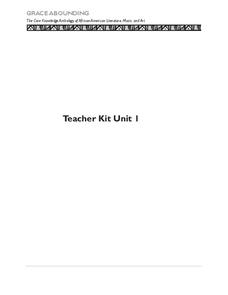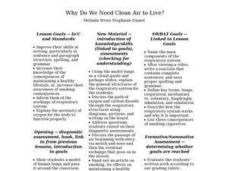Cornell University
Thinking with the Eyes
Objects are larger (or smaller) than they appear! Scholars use a laboratory investigation to explore the difference between resolution and magnification. The activity allows them to calculate the size of the field of view of their light...
101 Questions
Square Partitions
Challenge your classes while developing their problem-solving skills. A square is divided neatly into four equal triangles by its diagonals until one diagonal is moved from a vertex to the midpoint of one side. Now, scholars must devise...
Scholastic
Thanksgiving Lessons Grades PreK-2
A quintessential resource for teaching an elementary unit on the first Thanksgiving addresses a variety of skills, including informational reading, critical thinking, comparing and contrasting facts, technology tools, and historical...
Curated OER
Sectionalism, Popular Sovereignty and Secession
Learners read and discuss background material on several key decisions that played a role in the Civil War including the Missouri Compromise, the Kansas-Nebraska Act and the Dredd Scott Decision. They create a timeline and write an essay.
Novelinks
Where the Red Fern Grows: Anticipation Guide Strategy
How do you rise above your challenges? This is a question the anticipation guide for Where the Red Fern Grows answers. Full of questions and direct statements about themes of the text, pupils investigate whether or not the writer would...
K12 Reader
What's the Forecast?
Rain gauges, thermometers, and wind vanes. After reading a short article about weather forecasting, readers identify the tools meteorologists use to predict the weather.
Curated OER
The Talk Show: A Bioethical Dilemma About Neurological Disorders
Students explore neurological societal problems. They research, collect information and assess the ramifications of ethical, economic, political, and social issues. During a talk show simulation, students present their decisions.
Curated OER
Pumpkin Writing Paper
In this writing worksheet, students use the blank lined paper with a colorful pumpkin border for any kind of writing: reports, poetry, stories or letters.
Curated OER
P a g e - b y - P a g e
Students discuss the writing process and take notes on the five steps and how they can be used in other subjects. They examine a newspaper article and after reading it they identify the five W's and H. They brainstorm to come up with...
Curated OER
Writing the Blues
Students assess the blues as musical poetry. They place the writing of blues music in historical context and write (and read) their own blues lyrics. They perform for the class and others.
What happened to the frogs?
Students will select ten rubber frogs and determine their pollutant source based on their malformations. Students will write a brief essay on their findings. Students will be engaged in the lesson the entire time!
Curated OER
Engaging Young Scientists with Inquiry: Part Two
Evaluating data and learning to communicate the results is a big piece of the inquiry puzzle.
Google
Intermediate 2: Understanding Search Results
Teach your class some strategies for effective searching. Pupils should assess the whole results screen and then determine how to go forward with their searches. A table of strategies is included, as is a challenge. After they complete...
Inside Mathematics
Scatter Diagram
It is positive that how one performs on the first test relates to their performance on the second test. The three-question assessment has class members read and analyze a scatter plot of test scores. They must determine whether...
Curated OER
Setting Goals
Fourth graders view a PowerPoint presentation "Setting goals." They use Kidspiration to organize long and short term goals for academics. Students write essays about Goal Setting. Students work in groups and create a dialogue involving...
National Earth Science Teachers Association
The Earth Scientist Project
Pairs of learners choose an earth scientist from an extensive list. They collect information by researching online or in books about the childhood, education, and major contributions made by their chosen scientist. When they present...
Curated OER
Tell Me More
Fifth graders demonstrate research techniques in addition to endeavoring to display focus and stay on topic. Using books and stories, they gather, organize, and share information about a topic. Additionally, they explain to the class...
Curated OER
Ocean Commotion Activity - Dioramas
Groups make a model of an Ocean Commotion exhibit based on what they saw during the fieldtrip. These dioramas can be used as an informal assessment of student knowledge acquired at Ocean Commotion.
Curated OER
What do you know about earthquakes??
Ninth graders compare and contrast various writing styles and distinguish technical writing from other writing techniques. They assess personal knowledge regarding earthquakes and earthquake preparedness.
Curated OER
Career Magic
Fifth graders gather information about the roles, responsibilities, skills, and training and education requirements of workers. Then they input this information into a graphic organizer chart and identify the similarities and differences...
Curated OER
Teacher Kit Unit 1
Nine lessons makeup a unit designed to reinforce grammar and vocabulary through practice pages based on readings of African folktales. Each lesson consists of a mini lesson, a vocabulary review, and a worksheet. Topics include...
California Department of Education
Matching Interests and Careers Distance Learning Online Activity
Using the California CareerZone Interest Profiler results, scholars choose an occupation to research then write a summary about what they discovered.
Curated OER
Why Do We Need Clean Air to Live? - Biology Teaching Thesis
Students name the main components of the respiratory system. They write a reaction that contains complete sentences, and uses proper spelling and grammar, after viewing a video. Students define the following terms: lungs, respiration,...
Curated OER
Like It Or Not?
Write a review of the film adaptation of Holes. After viewing the film, your young reviewers make recommendations about viewing the film. Using details to support their opinions, they highlight the important parts of the movie without...


